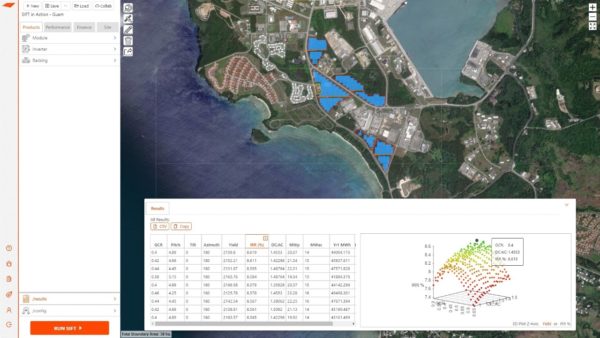The initial stages of PV project development can be expensive, stressful, and slow-moving as developers look to ensure maximum value and optimal generation for a project that might not be completed for several years.
Because this process is so arduous and forward-looking in nature, the results are not always perfect. Seemingly small oversights can have big financial implications. Different development software and data analysis models recognize this challenge and have been created to make life easier for developers by automating some of the processes.

One such software, developed by Sunfig, a company within Gibraltar’s Renewable Energy Group, the Sunfig Instant Feasibility Tool (SIFT), allows users to determine the optimum design for their projects. It promises 5-to-15% increases in returns for utility-scale solar projects.
The tool was developed to address the seemingly innocuous problems that Sunfig Founder and CEO, Ashton Vandemark, a solar industry veteran, noticed had major implications, including row spacing and optimal tilt angles.
Through years in project development, Vandemark has gained experience in financial and performance modeling, design, and product or technology applications, he told pv magazine. “I was in a unique position to see what was missing in the early stages of the project cycle and connect the dots to help other developers.”
What Vandemark and Sunfig developed is a tool that can accurately process hundreds of layouts, site conditions, performance goals, and financial models in seconds using a cloud-based architecture. The tool operates in a web browser, and, according to Vandemark, has been designed to be as accessible as it is effective.

Within the tool, users can load data regarding what hardware their project is looking to use. This includes everything from modules (bifacial or mono) to the inverter and racking system. Users can then enter their project’s geographic location to get data on expected weather conditions and system output, as well as a look at the terrain and project layout. There’s also an area to include project financial details.
Once these variables are plugged in, the tool delivers hundreds of potential site models, which can be filtered for specific developer interests, such as highest rate of return, lowest levelized cost of energy, or maximum net present value.
The real value that Vandemark sees in SIFT is in how project specifics can be rapidly changed, generating new optimized configurations in seconds.
Less praying
Vandemark said that SIFT’s approach to site optimization is similar to the difference between answering a question and building on a question that’s already been answered. Whereas other software focuses on supporting developers once they have a design basis, SIFT creates a roadmap to build an understanding of what a project’s possibilities may be at an even earlier stage of the process.
He said a significant amount of engineering exists between a SIFT output and an executed project, but it is available at the very front of the cycle and helps developers make data-driven decisions. “Instead of guessing, executing, and praying, you’re creating a roadmap and identifying the best possible path,” Vandemark said.
Vandemark said that he’d like to see additional upstream capabilities added to SIFT, such as flood zones or other potentially hazardous environmental variables. He also wants to work on the tool’s layout and presentation, specifically in terms of the reports that are generated. He said such changes would be more aesthetic improvements, rather than an overhaul.
When asked about whether or not he’ll add energy storage to the tool, Vandemark said that he has created a storage model, but wants to perfect and simplify it before moving to add that functionality.
This content is protected by copyright and may not be reused. If you want to cooperate with us and would like to reuse some of our content, please contact: editors@pv-magazine.com.









By submitting this form you agree to pv magazine using your data for the purposes of publishing your comment.
Your personal data will only be disclosed or otherwise transmitted to third parties for the purposes of spam filtering or if this is necessary for technical maintenance of the website. Any other transfer to third parties will not take place unless this is justified on the basis of applicable data protection regulations or if pv magazine is legally obliged to do so.
You may revoke this consent at any time with effect for the future, in which case your personal data will be deleted immediately. Otherwise, your data will be deleted if pv magazine has processed your request or the purpose of data storage is fulfilled.
Further information on data privacy can be found in our Data Protection Policy.